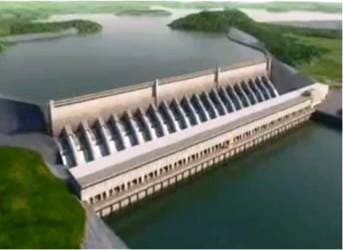Of the four BRIC nations, so beloved of Wall St. as the world’s economic future, only one, the Russian Federation, is a major energy exporter.
India and China are scouring the globe for energy imports.
Brazil, which two years ago became a modest hydrocarbon exporter, still needs to feed the rising energy needs of its population.
To that end, in Pará state in the Amazonian basin, Brazilian workers are feverishly laboring at the $14.4 billion Belo Monte dam on the Xingu river to complete the world’s largest hydroelectric facility, which, will generate 11,233 megawatts. When completed, Belo Monte will become the world’s third-largest dam generating electricity, exceeded only by China’s Three Gorges (20 megawatts) and Itaipu (14 megawatts), on the Brazilian border with Paraguay.
Hooray, right?
Depends who you talk to.
Norte Energia, the winning consortium of state-controlled firms and pension funds, has surmounted all legal challenges up to now. But not surprisingly, locals, including the Amerindian activist group Xingu Vivo (“Living Xingu”), have garnered some global heavyweight support, including U.S. filmmaker James Cameron, who has compared the Belo Monte dam-builders to the ecological villains in his blockbuster movie “Avatar.”
But wait a minute.
Related article: Russian Concerns over Central Asia Threaten Kyrgyzstan Hydroelectric Plant
Brazil was one of the first countries in the world to get into renewable energy, in the form of ethanol in the wake of the 1973 Arab oil embargo, and is now the world’s leading producer. Now, 46 percent of Brazil’s energy comes from renewable energy sources, and hydroelectric power plants currently produce over 85 percent of the nation’s electrical energy. In line with the current geopolitical buzz phrase “national energy security,” Brazil’s government has decided to press forward not only with Belo Monte but other new hydroelectric dams to guarantee the country’s energy security.
Well, now time for some bad PR. On 3 May 200 Amazon Indians occupied one of the three Belo Monte building sites, demanding that the Brazilian government hold prior consultations with indigenous peoples before building dams that affect their lands and livelihoods.
The legal disputes began in 1976, but last year, Brazil’s Supreme Court came down strongly in favor of the Belo Monte project, effectively leaving the opposition out of options.
The protest includes 100 Munduruku Indians from the Tapajos river, the only major river in the Amazon basin with no dams, but where the Brazilian government intends to construct a dozen more to meet Brazil's rapidly rising electricity demands.
And herein lies the crux of the issue. “The (Tsapajos is) only major river in the Amazon basin with no dams.”
The question arises, “qui bono?”
Not the Xingu, Munduruku, Juruna, Kayapo, Xipaya, Kuruaya, Asurini, Parakana and Ara Indian tribes which will be discomfited and displaced by Belo Monte and the other proposed hydroelectric projects.
Not only Brazilians, who will see unique cultures overwhelmed by the electrical needs of their more advanced consumer brethren, but in the end, people worldwide who still view human culture as more diverse than those aspiring to an apartment with electric power and a car in the garage.
Related article: Iran Abandons Chinese Help, to Build World’s Highest Hydroelectric Plant Alone
Brazil’s hydroelectric output already dwarfs that of other countries, but for those interested in increasing the nation’s electrical power grid, two-thirds of its hydro potential is untapped.
The bad news is that most of it lies in currently pristine rivers in the Amazon basin and of Brazilia’s 48 planned dams, 30 are in the Amazonian rainforest.
What do the protestors want?
According to a letter sent to the Brazilian government, the protestors said that Belo Monte's development has been progressing without consent or input from indigenous groups. "We want dialogue, but you are not letting us speak. This is why we are occupying your dam building site. You need to stop everything and simply listen to us. What we want is simple. You need to uphold the law and promote enacting legislation on free, prior and informed consent for indigenous peoples. Until that happens, you need to stop all construction, studies and police operations in the Xingu, Tapajos and Teles Pires rivers. And then you need to consult us."
Given the potential impact of the project, hardly sounds like an extreme request.
By. John C.K. Daly of Oilprice.com



















In addition, you have to reduce vibration to install floating solar plants. Because, it can make micro-cracks to floating solar panels and the durability problem of floating solar plants. The risk of power loss in PV modules due to micro cracks is increasing.
Vibrations caused by wind, waves and external forces. New Type Floating Body Stabilizer has been created in South Korea. The Floating Body Stabilizers generate drag force immediately when floating solar plants are being rolled, pitched and yawed on the water.
Recently, Restoring Force Strengthened Mooring Systems and Floating Body Stabilizers have been used for floating solar plants in South Korea.
You can see them in Ochang Dam natural reservoir, South Korea. I N I WORLD